Designing With Conifers: Exploring Color
http://decor-ideas.org 02/11/2015 01:13 Decor Ideas
Conifers are the workhorses and problem solvers of garden design. Much more colorful and varied than the Christmas trees that spring to mind, conifers offer year-round structure, texture and color, becoming the cornerstone of good garden design. Or so they should. Because they are strong, bold plants that command attention, many gardeners are reluctant to use more than one or two. The truth is that entire gardens can be built around them. Let’s explore color to help design with conifers.
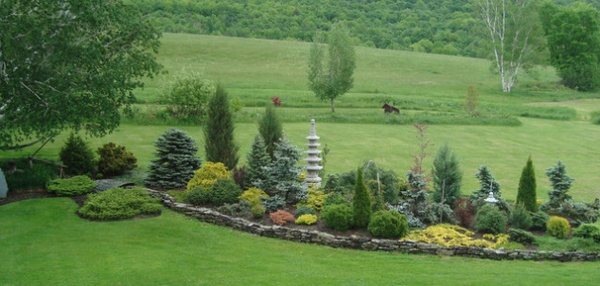
It is readily apparent from this photo that conifers are anything but predictable and boring. They come in an array of colors, shapes, sizes and textures. Conifers can be combined in ways to rival even the most thoughtfully designed perennial beds with regard to these four elements. Bonus: When those multicolored perennial beds are asleep for the winter, conifer gardens continue to shine with color.
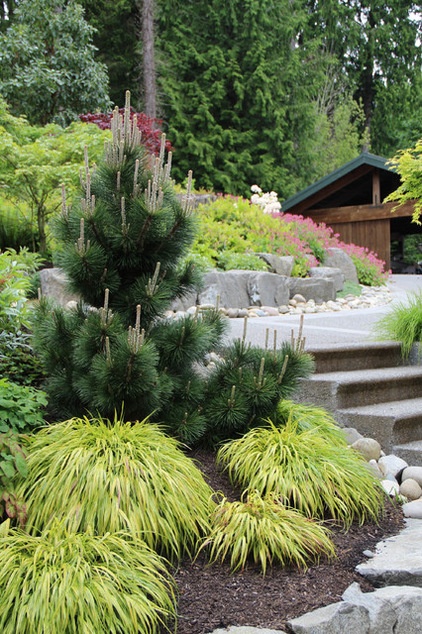
Consider green for structure. Dark green conifers are far from predictable and mundane. They function as the backbone of the garden, proving to be the strong, silent type that allow their companions to shine. What they lack in vivid color, they compensate for with form and texture. Dark green performs a necessary function in a colorful garden by offering a place for the eye to rest between jolts of color.
As an anchor plant, Thunderhead pine (Pinus thunbergii ‘Thunderhead’, USDA zones 5 to 10; find your zone), shown in this photo, stands regally in a sea of chartreuse. Its muscular upright growth habit pulls the eye up the steps and onto the garden’s next level while contrasting with the low mounding form of the golden Japanese forest grass (Hakonechloa macra ‘Aureola’, zones 4 to 9).
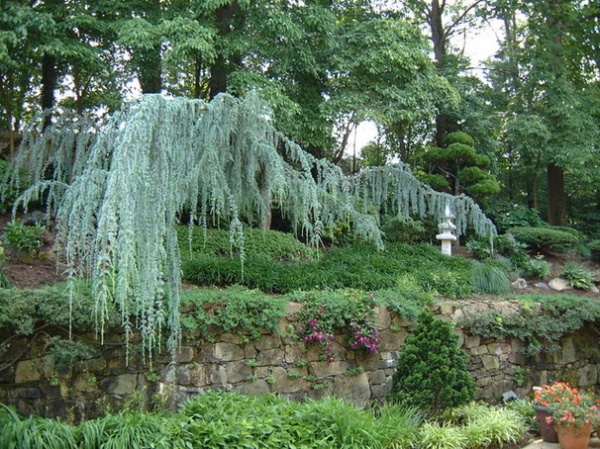
Cool with blue. Blue is the great mediator in garden design. It has a soothing effect on the mind and calms even the most vivid oranges and pinks. It also reads as a neutral; think of blue jeans. What doesn’t go with blue jeans?
Blue conifers, such as this weeping blue atlas cedar (Cedrus atlantica ‘Glauca Pendula’, zones 6 to 9) can also function as spectacular focal points. This specimen adds a mysterious ghostly quality to the garden.
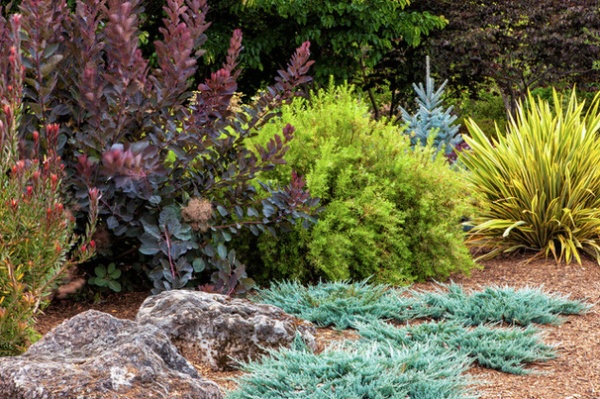
Much in the same way as the trinity of onions, celery and carrots are invaluable in the culinary world, chartreuse, burgundy and blue are an invaluable trinity in garden design. Notice how in this photo the Blue Chip juniper (Juniperus horizontalis ‘Blue Chip’, zones 3 to 9) in the foreground and the blue spruce (Picea pungens ‘Fat Albert’, zones 2 to 8) in the background provide a sense of calm and continuity to the burgundy and chartreuse Leucadendron ‘Safari Sunset’ (left), Cotinus ‘Grace’, Spirea thunbergii ‘Mt. Fuji’ and Phormium ‘Golden Ray.’ Without the blue-green conifers, the composition would visually fall apart.
Photo by Janice LeCocq Photography
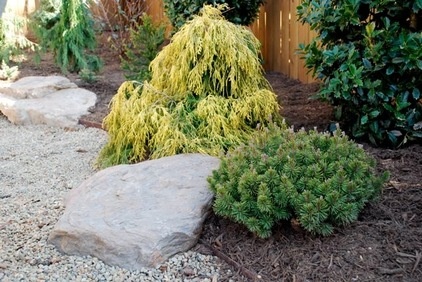
Brighten with yellow. Yellow is bold and cheerful, never to be ignored. Used sparingly it creates an unforgettable focal point in the garden. It lends itself to an elegant vignette when placed alongside black patio furniture or foliage.
Some yellows can appear brassy, so choose this hue thoughtfully. Some yellow conifers, such as this Lemon Thread false cypress (Chamaecyparis pisifera ‘Lemon Thread’, zones 4 to 8), require nearly full sun, while others will scorch in sunny gardens.
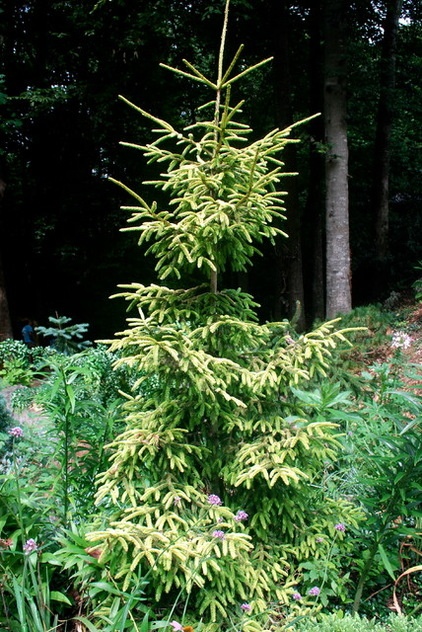
Add elegance with chartreuse. Chartreuse is cheerful and elegant, is easy to work with and lacks the brassiness that yellow can have. Plants such as this Skylands Oriental spruce (Picea orientalis ‘Skylands’, zones 4 to 7) prefer partial shade and are a welcome respite from the dark green foliage that often seems to rule the shade garden.
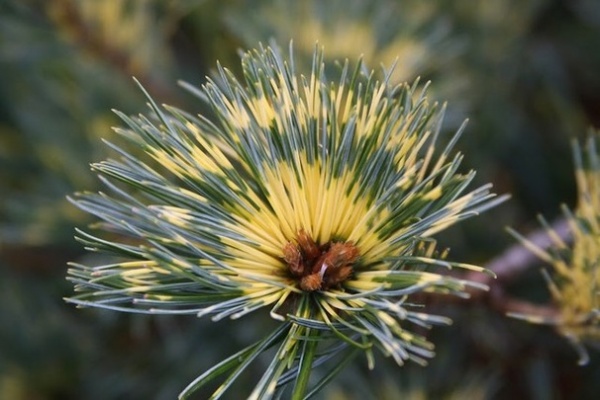
Mix it up with variegation. Conifers with variegated foliage add an element of surprise. They can also be useful mediators, bringing plants with differing hues together. Consider this Ogon-janome Japanese white pine (Pinus parviflora ‘Ogon-janome’, zones 5 to 9). In my garden it lives between Skylands Oriental spruce and Feelin’ Blue deodar cedar (Cedrus deodara ‘Feelin’ Blue’, zones 7 to 9).
In shadier areas consider Gentsch White hemlock (Tsuga canadensis ‘Gentsch White’, zones 3 to 7). Its white-tipped foliage makes it the perfect companion for the variegated Patriot hosta (Hosta ‘Patriot’, zones 3 to 8).
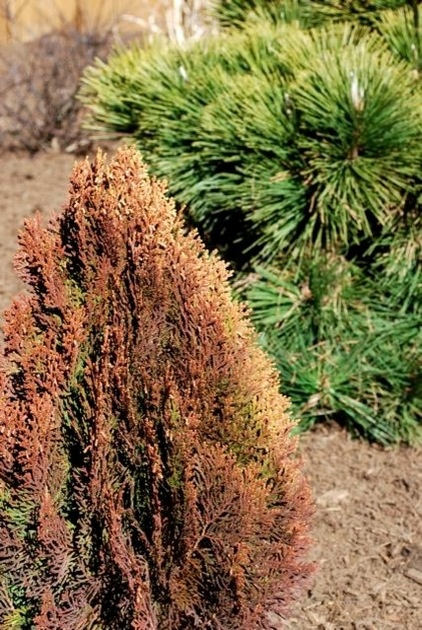
Play with seasonal color. Some conifers put on an unexpected color show in winter while still providing structure and texture when the garden needs it most desperately. Dwarf Morgan arborvitae (Thuja orientalis ‘Morgan’, zones 5 to 8), seen here in the foreground, sports lime-green foliage in the warmer months that changes to a rich orange in winter. Some junipers turn purple or bronze in winter.
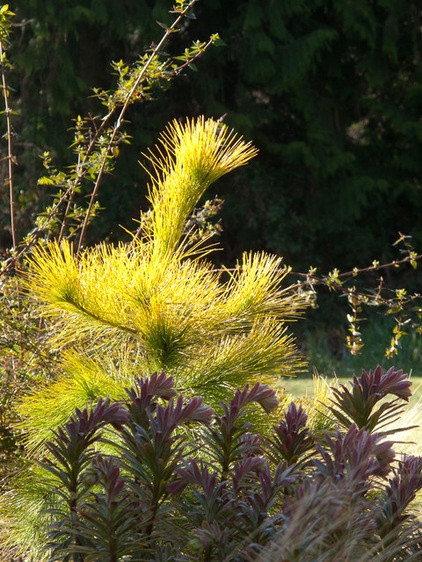
Certain pines, such as this Louie eastern white pine (Pinus strobus ‘Louie’, zones 3 to 8) and Chief Joseph lodgepole pine (Pinus contorta ‘Chief Joseph’, zones 5 to 8), put on quite the winter show when their foliage changes from light green to brilliant yellow.
Explore the colorful possibilities of adding conifers to your garden. These plants are anything but predictable and boring.
More: How to Help Your Home Fit Into the Landscape
Related Articles Recommended












